[English] 日本語
 Yorodumi
Yorodumi- EMDB-7535: Structure of the 2alpha3beta stiochiometry of the human Alpha4Bet... -
+ Open data
Open data
- Basic information
Basic information
| Entry | Database: EMDB / ID: EMD-7535 | ||||||||||||
|---|---|---|---|---|---|---|---|---|---|---|---|---|---|
| Title | Structure of the 2alpha3beta stiochiometry of the human Alpha4Beta2 nicotinic receptor | ||||||||||||
 Map data Map data | |||||||||||||
 Sample Sample |
| ||||||||||||
 Keywords Keywords | Ligand-gated ion channel / Acetylcholine receptor / Cys-loop Receptor / MEMBRANE PROTEIN / TRANSPORT PROTEIN | ||||||||||||
| Function / homology |  Function and homology information Function and homology informationvestibulocochlear nerve development / lateral geniculate nucleus development / regulation of circadian sleep/wake cycle, REM sleep / regulation of synaptic transmission, dopaminergic / optic nerve morphogenesis / Highly sodium permeable postsynaptic acetylcholine nicotinic receptors / Highly calcium permeable nicotinic acetylcholine receptors / central nervous system projection neuron axonogenesis / synaptic transmission involved in micturition / response to acetylcholine ...vestibulocochlear nerve development / lateral geniculate nucleus development / regulation of circadian sleep/wake cycle, REM sleep / regulation of synaptic transmission, dopaminergic / optic nerve morphogenesis / Highly sodium permeable postsynaptic acetylcholine nicotinic receptors / Highly calcium permeable nicotinic acetylcholine receptors / central nervous system projection neuron axonogenesis / synaptic transmission involved in micturition / response to acetylcholine / negative regulation of action potential / Highly calcium permeable postsynaptic nicotinic acetylcholine receptors / acetylcholine receptor activity / regulation of dopamine metabolic process / acetylcholine-gated channel complex / positive regulation of dopamine secretion / behavioral response to nicotine / neuromuscular synaptic transmission / acetylcholine-gated monoatomic cation-selective channel activity / cation channel complex / acetylcholine binding / synaptic transmission, cholinergic / nervous system process / acetylcholine receptor signaling pathway / neurotransmitter receptor complex / ligand-gated monoatomic ion channel activity / inhibitory postsynaptic potential / regulation of dendrite morphogenesis / regulation of synapse assembly / regulation of dopamine secretion / B cell activation / action potential / associative learning / smooth muscle contraction / plasma membrane raft / membrane depolarization / social behavior / positive regulation of B cell proliferation / monoatomic ion transport / visual perception / sensory perception of pain / learning / response to nicotine / response to cocaine / regulation of membrane potential / locomotory behavior / sensory perception of sound / visual learning / memory / cognition / calcium ion transport / presynaptic membrane / response to oxidative stress / monoatomic ion transmembrane transport / response to ethanol / chemical synaptic transmission / postsynaptic membrane / response to hypoxia / neuron projection / external side of plasma membrane / DNA repair / neuronal cell body / synapse / dendrite / signal transduction / membrane / plasma membrane Similarity search - Function | ||||||||||||
| Biological species |  Homo sapiens (human) / Homo sapiens (human) /  | ||||||||||||
| Method | single particle reconstruction / cryo EM / Resolution: 3.7 Å | ||||||||||||
 Authors Authors | Walsh Jr RM / Roh SH | ||||||||||||
| Funding support |  United States, 3 items United States, 3 items
| ||||||||||||
 Citation Citation |  Journal: Nature / Year: 2018 Journal: Nature / Year: 2018Title: Structural principles of distinct assemblies of the human α4β2 nicotinic receptor. Authors: Richard M Walsh / Soung-Hun Roh / Anant Gharpure / Claudio L Morales-Perez / Jinfeng Teng / Ryan E Hibbs /  Abstract: Fast chemical communication in the nervous system is mediated by neurotransmitter-gated ion channels. The prototypical member of this class of cell surface receptors is the cation-selective nicotinic ...Fast chemical communication in the nervous system is mediated by neurotransmitter-gated ion channels. The prototypical member of this class of cell surface receptors is the cation-selective nicotinic acetylcholine receptor. As with most ligand-gated ion channels, nicotinic receptors assemble as oligomers of subunits, usually as hetero-oligomers and often with variable stoichiometries . This intrinsic heterogeneity in protein composition provides fine tunability in channel properties, which is essential to brain function, but frustrates structural and biophysical characterization. The α4β2 subtype of the nicotinic acetylcholine receptor is the most abundant isoform in the human brain and is the principal target in nicotine addiction. This pentameric ligand-gated ion channel assembles in two stoichiometries of α- and β-subunits (2α:3β and 3α:2β). Both assemblies are functional and have distinct biophysical properties, and an imbalance in the ratio of assemblies is linked to both nicotine addiction and congenital epilepsy. Here we leverage cryo-electron microscopy to obtain structures of both receptor assemblies from a single sample. Antibody fragments specific to β2 were used to 'break' symmetry during particle alignment and to obtain high-resolution reconstructions of receptors of both stoichiometries in complex with nicotine. The results reveal principles of subunit assembly and the structural basis of the distinctive biophysical and pharmacological properties of the two different stoichiometries of this receptor. | ||||||||||||
| History |
|
- Structure visualization
Structure visualization
| Movie |
 Movie viewer Movie viewer |
|---|---|
| Structure viewer | EM map:  SurfView SurfView Molmil Molmil Jmol/JSmol Jmol/JSmol |
| Supplemental images |
- Downloads & links
Downloads & links
-EMDB archive
| Map data |  emd_7535.map.gz emd_7535.map.gz | 55.2 MB |  EMDB map data format EMDB map data format | |
|---|---|---|---|---|
| Header (meta data) |  emd-7535-v30.xml emd-7535-v30.xml emd-7535.xml emd-7535.xml | 25.3 KB 25.3 KB | Display Display |  EMDB header EMDB header |
| FSC (resolution estimation) |  emd_7535_fsc_1.xml emd_7535_fsc_1.xml emd_7535_fsc_2.xml emd_7535_fsc_2.xml | 8.9 KB 8.9 KB | Display Display |  FSC data file FSC data file |
| Images |  emd_7535_1.png emd_7535_1.png emd_7535_2.png emd_7535_2.png emd_7535_3.png emd_7535_3.png | 31.2 KB 80.2 KB 84.5 KB | ||
| Filedesc metadata |  emd-7535.cif.gz emd-7535.cif.gz | 7.8 KB | ||
| Others |  emd_7535_half_map_1.map.gz emd_7535_half_map_1.map.gz emd_7535_half_map_2.map.gz emd_7535_half_map_2.map.gz | 53.1 MB 53 MB | ||
| Archive directory |  http://ftp.pdbj.org/pub/emdb/structures/EMD-7535 http://ftp.pdbj.org/pub/emdb/structures/EMD-7535 ftp://ftp.pdbj.org/pub/emdb/structures/EMD-7535 ftp://ftp.pdbj.org/pub/emdb/structures/EMD-7535 | HTTPS FTP |
-Validation report
| Summary document |  emd_7535_validation.pdf.gz emd_7535_validation.pdf.gz | 894.3 KB | Display |  EMDB validaton report EMDB validaton report |
|---|---|---|---|---|
| Full document |  emd_7535_full_validation.pdf.gz emd_7535_full_validation.pdf.gz | 893.8 KB | Display | |
| Data in XML |  emd_7535_validation.xml.gz emd_7535_validation.xml.gz | 12 KB | Display | |
| Data in CIF |  emd_7535_validation.cif.gz emd_7535_validation.cif.gz | 14.2 KB | Display | |
| Arichive directory |  https://ftp.pdbj.org/pub/emdb/validation_reports/EMD-7535 https://ftp.pdbj.org/pub/emdb/validation_reports/EMD-7535 ftp://ftp.pdbj.org/pub/emdb/validation_reports/EMD-7535 ftp://ftp.pdbj.org/pub/emdb/validation_reports/EMD-7535 | HTTPS FTP |
-Related structure data
| Related structure data |  6cnjMC  7536C  6cnkC M: atomic model generated by this map C: citing same article ( |
|---|---|
| Similar structure data |
- Links
Links
| EMDB pages |  EMDB (EBI/PDBe) / EMDB (EBI/PDBe) /  EMDataResource EMDataResource |
|---|---|
| Related items in Molecule of the Month |
- Map
Map
| File |  Download / File: emd_7535.map.gz / Format: CCP4 / Size: 59.6 MB / Type: IMAGE STORED AS FLOATING POINT NUMBER (4 BYTES) Download / File: emd_7535.map.gz / Format: CCP4 / Size: 59.6 MB / Type: IMAGE STORED AS FLOATING POINT NUMBER (4 BYTES) | ||||||||||||||||||||||||||||||||||||||||||||||||||||||||||||
|---|---|---|---|---|---|---|---|---|---|---|---|---|---|---|---|---|---|---|---|---|---|---|---|---|---|---|---|---|---|---|---|---|---|---|---|---|---|---|---|---|---|---|---|---|---|---|---|---|---|---|---|---|---|---|---|---|---|---|---|---|---|
| Projections & slices | Image control
Images are generated by Spider. | ||||||||||||||||||||||||||||||||||||||||||||||||||||||||||||
| Voxel size | X=Y=Z: 1.07 Å | ||||||||||||||||||||||||||||||||||||||||||||||||||||||||||||
| Density |
| ||||||||||||||||||||||||||||||||||||||||||||||||||||||||||||
| Symmetry | Space group: 1 | ||||||||||||||||||||||||||||||||||||||||||||||||||||||||||||
| Details | EMDB XML:
CCP4 map header:
| ||||||||||||||||||||||||||||||||||||||||||||||||||||||||||||
-Supplemental data
-Half map: #1
| File | emd_7535_half_map_1.map | ||||||||||||
|---|---|---|---|---|---|---|---|---|---|---|---|---|---|
| Projections & Slices |
| ||||||||||||
| Density Histograms |
-Half map: #2
| File | emd_7535_half_map_2.map | ||||||||||||
|---|---|---|---|---|---|---|---|---|---|---|---|---|---|
| Projections & Slices |
| ||||||||||||
| Density Histograms |
- Sample components
Sample components
-Entire : Complex of three Fab fragments with the 2alpha3beta stoichiometry...
| Entire | Name: Complex of three Fab fragments with the 2alpha3beta stoichiometry of the human Alpha4Beta2 nicotinic receptor |
|---|---|
| Components |
|
-Supramolecule #1: Complex of three Fab fragments with the 2alpha3beta stoichiometry...
| Supramolecule | Name: Complex of three Fab fragments with the 2alpha3beta stoichiometry of the human Alpha4Beta2 nicotinic receptor type: complex / ID: 1 / Parent: 0 / Macromolecule list: #1-#4 Details: Fab fragmented generated by proteolytic cleavage of IgG antibody |
|---|---|
| Source (natural) | Organism:  Homo sapiens (human) Homo sapiens (human) |
| Molecular weight | Theoretical: 344 KDa |
-Macromolecule #1: Neuronal acetylcholine receptor subunit alpha-4
| Macromolecule | Name: Neuronal acetylcholine receptor subunit alpha-4 / type: protein_or_peptide / ID: 1 / Number of copies: 2 / Enantiomer: LEVO |
|---|---|
| Source (natural) | Organism:  Homo sapiens (human) Homo sapiens (human) |
| Molecular weight | Theoretical: 44.862367 KDa |
| Recombinant expression | Organism:  Homo sapiens (human) Homo sapiens (human) |
| Sequence | String: SSHVETRAHA EERLLKKLFS GYNKWSRPVA NISDVVLVRF GLSIAQLIDV DEKNQMMTTN VWVKQEWHDY KLRWDPADYE NVTSIRIPS ELIWRPDIVL YNNADGDFAV THLTKAHLFH DGRVQWTPPA IYKSSCSIDV TFFPFDQQNC TMKFGSWTYD K AKIDLVNM ...String: SSHVETRAHA EERLLKKLFS GYNKWSRPVA NISDVVLVRF GLSIAQLIDV DEKNQMMTTN VWVKQEWHDY KLRWDPADYE NVTSIRIPS ELIWRPDIVL YNNADGDFAV THLTKAHLFH DGRVQWTPPA IYKSSCSIDV TFFPFDQQNC TMKFGSWTYD K AKIDLVNM HSRVDQLDFW ESGEWVIVDA VGTYNTRKYE CCAEIYPDIT YAFVIRRLPL FYTINLIIPC LLISCLTVLV FY LPSECGE KITLCISVLL SLTVFLLLIT EIIPSTSLVI PLIGEYLLFT MIFVTLSIVI TVFVLNVHHR SPRTHTMPTW VRR VFLDIV PRLLLMKRPS VVDTDFERSV KEDWKYVAMV IDRIFLWMFI IVCLLGTVGL FLPPWLAGMI UniProtKB: Neuronal acetylcholine receptor subunit alpha-4, Neuronal acetylcholine receptor subunit alpha-4 |
-Macromolecule #2: Neuronal acetylcholine receptor subunit beta-2
| Macromolecule | Name: Neuronal acetylcholine receptor subunit beta-2 / type: protein_or_peptide / ID: 2 / Number of copies: 3 / Enantiomer: LEVO |
|---|---|
| Source (natural) | Organism:  Homo sapiens (human) Homo sapiens (human) |
| Molecular weight | Theoretical: 46.748863 KDa |
| Recombinant expression | Organism:  Homo sapiens (human) Homo sapiens (human) |
| Sequence | String: TDTEERLVEH LLDPSRYNKL IRPATNGSEL VTVQLMVSLA QLISVHEREQ IMTTNVWLTQ EWEDYRLTWK PEEFDNMKKV RLPSKHIWL PDVVLYNNAD GMYEVSFYSN AVVSYDGSIF WLPPAIYKSA CKIEVKHFPF DQQNCTMKFR SWTYDRTEID L VLKSEVAS ...String: TDTEERLVEH LLDPSRYNKL IRPATNGSEL VTVQLMVSLA QLISVHEREQ IMTTNVWLTQ EWEDYRLTWK PEEFDNMKKV RLPSKHIWL PDVVLYNNAD GMYEVSFYSN AVVSYDGSIF WLPPAIYKSA CKIEVKHFPF DQQNCTMKFR SWTYDRTEID L VLKSEVAS LDDFTPSGEW DIVALPGRRN ENPDDSTYVD ITYDFIIRRK PLFYTINLII PCVLITSLAI LVFYLPSDCG EK MTLCISV LLALTVFLLL ISKIVPPTSL DVPLVGKYLM FTMVLVTFSI VTSVCVLNVH HRSPTTHTMA PWVKVVFLEK LPA LLFMQQ PRHHDDDQER SVSEDWKYVA MVIDRLFLWI FVFVCVFGTI GMFLQPLFQN YTTTTFLHSD HSAPSSKSAW SHPQ FEK UniProtKB: Neuronal acetylcholine receptor subunit beta-2, Neuronal acetylcholine receptor subunit beta-2 |
-Macromolecule #3: IgG1 Kappa Light Chain
| Macromolecule | Name: IgG1 Kappa Light Chain / type: protein_or_peptide / ID: 3 / Number of copies: 3 / Enantiomer: LEVO |
|---|---|
| Source (natural) | Organism:  |
| Molecular weight | Theoretical: 26.378596 KDa |
| Sequence | String: MKLPVRLLVL MFWIPASSSD VLMTQTPLSL PVSLGDQASI SCRSSQSIVH SNGNTYLEWY LQKPGQSPKL LIYKVSNRFS GVPDRFSGS GSGTDFTLKI SRVEAEDLGV YYCFQGSHVP WTFGGGTKLE IKRADAAPTV SIFPPSSEQL TSGGASVVCF L NNFYPKDI ...String: MKLPVRLLVL MFWIPASSSD VLMTQTPLSL PVSLGDQASI SCRSSQSIVH SNGNTYLEWY LQKPGQSPKL LIYKVSNRFS GVPDRFSGS GSGTDFTLKI SRVEAEDLGV YYCFQGSHVP WTFGGGTKLE IKRADAAPTV SIFPPSSEQL TSGGASVVCF L NNFYPKDI NVKWKIDGSE RQNGVLNSWT DQDSKDSTYS MSSTLTLTKD EYERHNSYTC EATHKTSTSP IVKSFNRNEC |
-Macromolecule #4: IgG1 Heavy Chain
| Macromolecule | Name: IgG1 Heavy Chain / type: protein_or_peptide / ID: 4 / Number of copies: 3 / Enantiomer: LEVO |
|---|---|
| Source (natural) | Organism:  |
| Molecular weight | Theoretical: 51.195668 KDa |
| Sequence | String: MEWTWVFLFL LSVTAGVHSQ VQLQQSGAEV MKPGASVKIS CKGTGYTFSS YWIEWVKQRP GHGLERIGEI LPGSGSTNYN EKFRGKATF TADKSSKTAY MQLSSLTSED SAVYYCARYL PYYYAMDYWG QGTSVTVSSA KTTPPSVYPL APGSAAQTNS M VTLGCLVK ...String: MEWTWVFLFL LSVTAGVHSQ VQLQQSGAEV MKPGASVKIS CKGTGYTFSS YWIEWVKQRP GHGLERIGEI LPGSGSTNYN EKFRGKATF TADKSSKTAY MQLSSLTSED SAVYYCARYL PYYYAMDYWG QGTSVTVSSA KTTPPSVYPL APGSAAQTNS M VTLGCLVK GYFPEPVTVT WNSGSLSSGV HTFPAVLQSD LYTLSSSVTV PSSTWPSETV TCNVAHPASS TKVDKKIVPR DC GCKPCIC TVPEVSSVFI FPPKPKDVLT ITLTPKVTCV VVDISKDDPE VQFSWFVDDV EVHTAQTQPR EEQFNSTFRS VSE LPIMHQ DWLNGKEFKC RVNSAAFPAP IEKTISKTKG RPKAPQVYTI PPPKEQMAKD KVSLTCMITD FFPEDITVEW QWNG QPAEN YKNTQPIMDT DGSYFVYSKL NVQKSNWEAG NTFTCSVLHE GLHNHHTEKS LSHSPGK |
-Macromolecule #6: 2-acetamido-2-deoxy-beta-D-glucopyranose
| Macromolecule | Name: 2-acetamido-2-deoxy-beta-D-glucopyranose / type: ligand / ID: 6 / Number of copies: 2 / Formula: NAG |
|---|---|
| Molecular weight | Theoretical: 221.208 Da |
| Chemical component information |  ChemComp-NAG: |
-Macromolecule #7: (S)-3-(1-METHYLPYRROLIDIN-2-YL)PYRIDINE
| Macromolecule | Name: (S)-3-(1-METHYLPYRROLIDIN-2-YL)PYRIDINE / type: ligand / ID: 7 / Number of copies: 2 / Formula: NCT |
|---|---|
| Molecular weight | Theoretical: 162.232 Da |
| Chemical component information |  ChemComp-NCT: |
-Macromolecule #8: CHOLESTEROL HEMISUCCINATE
| Macromolecule | Name: CHOLESTEROL HEMISUCCINATE / type: ligand / ID: 8 / Number of copies: 10 / Formula: Y01 |
|---|---|
| Molecular weight | Theoretical: 486.726 Da |
| Chemical component information |  ChemComp-Y01: |
-Macromolecule #9: SODIUM ION
| Macromolecule | Name: SODIUM ION / type: ligand / ID: 9 / Number of copies: 1 |
|---|---|
| Molecular weight | Theoretical: 22.99 Da |
-Experimental details
-Structure determination
| Method | cryo EM |
|---|---|
 Processing Processing | single particle reconstruction |
| Aggregation state | particle |
- Sample preparation
Sample preparation
| Concentration | 6 mg/mL | |||||||||||||||||||||
|---|---|---|---|---|---|---|---|---|---|---|---|---|---|---|---|---|---|---|---|---|---|---|
| Buffer | pH: 7.4 Component:
| |||||||||||||||||||||
| Grid | Model: Quantifoil R1.2/1.3 / Material: GOLD / Mesh: 200 / Pretreatment - Type: GLOW DISCHARGE / Pretreatment - Time: 80 sec. / Pretreatment - Atmosphere: AIR / Pretreatment - Pressure: 39.0 kPa Details: Sample was glow discharged at 30mA for 80 seconds using a PELCO easiGLow | |||||||||||||||||||||
| Vitrification | Cryogen name: ETHANE / Chamber humidity: 100 % / Chamber temperature: 277 K / Instrument: FEI VITROBOT MARK IV / Details: 4 second blot time. |
- Electron microscopy
Electron microscopy
| Microscope | FEI TITAN KRIOS |
|---|---|
| Temperature | Min: 80.0 K / Max: 90.0 K |
| Specialist optics | Energy filter - Name: GIF Quantum LS / Energy filter - Lower energy threshold: -10 eV / Energy filter - Upper energy threshold: 10 eV |
| Image recording | Film or detector model: GATAN K2 SUMMIT (4k x 4k) / Detector mode: SUPER-RESOLUTION / Number grids imaged: 2 / Number real images: 5166 / Average exposure time: 15.0 sec. / Average electron dose: 75.0 e/Å2 |
| Electron beam | Acceleration voltage: 300 kV / Electron source:  FIELD EMISSION GUN FIELD EMISSION GUN |
| Electron optics | C2 aperture diameter: 70.0 µm / Calibrated magnification: 46730 / Illumination mode: FLOOD BEAM / Imaging mode: BRIGHT FIELD / Cs: 2.7 mm / Nominal defocus max: 4.5 µm / Nominal defocus min: 0.5 µm |
| Sample stage | Specimen holder model: FEI TITAN KRIOS AUTOGRID HOLDER / Cooling holder cryogen: NITROGEN |
| Experimental equipment |  Model: Titan Krios / Image courtesy: FEI Company |
+ Image processing
Image processing
-Atomic model buiding 1
| Refinement | Space: REAL / Protocol: AB INITIO MODEL |
|---|---|
| Output model |  PDB-6cnj: |
 Movie
Movie Controller
Controller


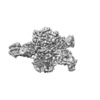

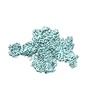
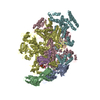

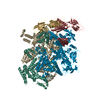
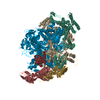

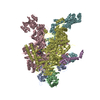
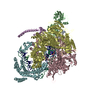
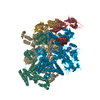


 Z (Sec.)
Z (Sec.) Y (Row.)
Y (Row.) X (Col.)
X (Col.)






































